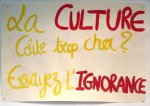Accueil > Revue de presse > À l’étranger > Education Gap Grows Between Rich and Poor, Studies Say, Sabrina Tavernise, (...)
 Education Gap Grows Between Rich and Poor, Studies Say, Sabrina Tavernise, The New York Times, 9 février 2012
Education Gap Grows Between Rich and Poor, Studies Say, Sabrina Tavernise, The New York Times, 9 février 2012
lundi 13 février 2012
A lire sur le site du New York Times
WASHINGTON — Education was historically considered a great equalizer in American society, capable of lifting less advantaged children and improving their chances for success as adults. But a body of recently published scholarship suggests that the achievement gap between rich and poor children is widening, a development that threatens to dilute education’s leveling effects.
It is a well-known fact that children from affluent families tend to do better in school. Yet the income divide has received far less attention from policy makers and government officials than gaps in student accomplishment by race.
Now, in analyses of long-term data published in recent months, researchers are finding that while the achievement gap between white and black students has narrowed significantly over the past few decades, the gap between rich and poor students has grown substantially during the same period.
“We have moved from a society in the 1950s and 1960s, in which race was more consequential than family income, to one today in which family income appears more determinative of educational success than race,” said Sean F. Reardon, a Stanford University sociologist. Professor Reardon is the author of a study that found that the gap in standardized test scores between affluent and low-income students had grown by about 40 percent since the 1960s, and is now double the testing gap between blacks and whites.
In another study, by researchers from the University of Michigan, the imbalance between rich and poor children in college completion — the single most important predictor of success in the work force — has grown by about 50 percent since the late 1980s.
The changes are tectonic, a result of social and economic processes unfolding over many decades. The data from most of these studies end in 2007 and 2008, before the recession’s full impact was felt. Researchers said that based on experiences during past recessions, the recent downturn was likely to have aggravated the trend.
“With income declines more severe in the lower brackets, there’s a good chance the recession may have widened the gap,” Professor Reardon said. In the study he led, researchers analyzed 12 sets of standardized test scores starting in 1960 and ending in 2007. He compared children from families in the 90th percentile of income — the equivalent of around $160,000 in 2008, when the study was conducted — and children from the 10th percentile, $17,500 in 2008. By the end of that period, the achievement gap by income had grown by 40 percent, he said, while the gap between white and black students, regardless of income, had shrunk substantially.
Both studies were first published last fall in a book of research, “Whither Opportunity ?” compiled by the Russell Sage Foundation, a research center for social sciences, and the Spencer Foundation, which focuses on education. Their conclusions, while familiar to a small core of social sciences scholars, are now catching the attention of a broader audience, in part because income inequality has been a central theme this election season.
The connection between income inequality among parents and the social mobility of their children has been a focus of President Obama as well as some of the Republican presidential candidates.
One reason for the growing gap in achievement, researchers say, could be that wealthy parents invest more time and money than ever before in their children (in weekend sports, ballet, music lessons, math tutors, and in overall involvement in their children’s schools), while lower-income families, which are now more likely than ever to be headed by a single parent, are increasingly stretched for time and resources. This has been particularly true as more parents try to position their children for college, which has become ever more essential for success in today’s economy.
A study by Sabino Kornrich, a researcher at the Center for Advanced Studies at the Juan March Institute in Madrid, and Frank F. Furstenberg, scheduled to appear in the journal Demography this year, found that in 1972, Americans at the upper end of the income spectrum were spending five times as much per child as low-income families. By 2007 that gap had grown to nine to one ; spending by upper-income families more than doubled, while spending by low-income families grew by 20 percent.
“The pattern of privileged families today is intensive cultivation,” said Dr. Furstenberg, a professor of sociology at the University of Pennsylvania.
The gap is also growing in college. The University of Michigan study, by Susan M. Dynarski and Martha J. Bailey, looked at two generations of students, those born from 1961 to 1964 and those born from 1979 to 1982. By 1989, about one-third of the high-income students in the first generation had finished college ; by 2007, more than half of the second generation had done so. By contrast, only 9 percent of the low-income students in the second generation had completed college by 2007, up only slightly from a 5 percent college completion rate by the first generation in 1989.
James J. Heckman, an economist at the University of Chicago, argues that parenting matters as much as, if not more than, income in forming a child’s cognitive ability and personality, particularly in the years before children start school.
“Early life conditions and how children are stimulated play a very important role,” he said. “The danger is we will revert back to the mindset of the war on poverty, when poverty was just a matter of income, and giving families more would improve the prospects of their children. If people conclude that, it’s a mistake.”
Meredith Phillips, an associate professor of public policy and sociology at the University of California, Los Angeles, used survey data to show that affluent children spend 1,300 more hours than low-income children before age 6 in places other than their homes, their day care centers, or schools (anywhere from museums to shopping malls). By the time high-income children start school, they have spent about 400 hours more than poor children in literacy activities, she found.
Charles Murray, a scholar at the American Enterprise Institute whose book, “Coming Apart : The State of White America, 1960-2010,” was published Jan. 31, described income inequality as “more of a symptom than a cause.”
The growing gap between the better educated and the less educated, he argued, has formed a kind of cultural divide that has its roots in natural social forces, like the tendency of educated people to marry other educated people, as well as in the social policies of the 1960s, like welfare and other government programs, which he contended provided incentives for staying single.
“When the economy recovers, you’ll still see all these problems persisting for reasons that have nothing to do with money and everything to do with culture,” he said.
There are no easy answers, in part because the problem is so complex, said Douglas J. Besharov, a fellow at the Atlantic Council. Blaming the problem on the richest of the rich ignores an equally important driver, he said : two-earner household wealth, which has lifted the upper middle class ever further from less educated Americans, who tend to be single parents.
The problem is a puzzle, he said. “No one has the slightest idea what will work. The cupboard is bare.”
A lire aussi : la discussion continue sur un blog du Times


